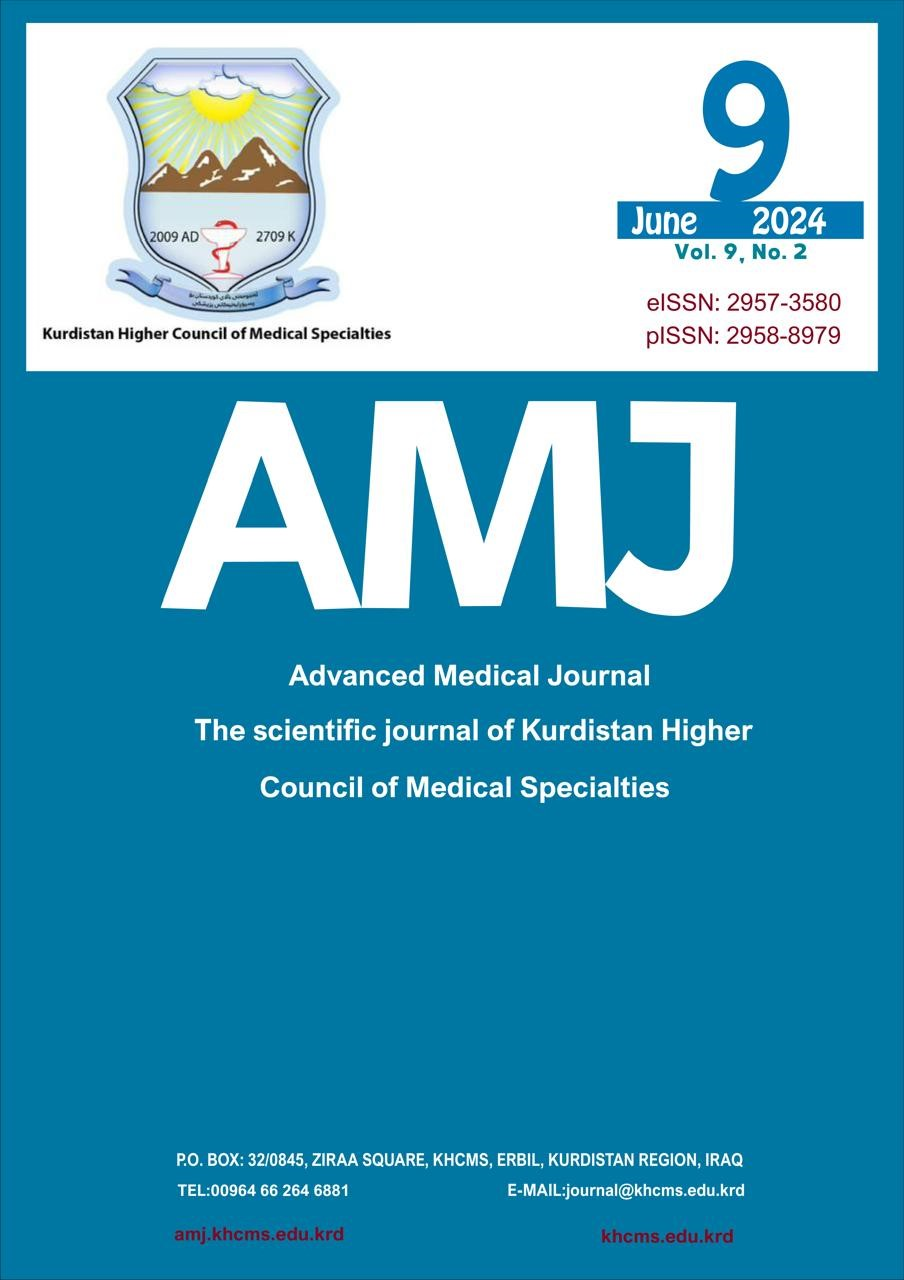Haematological parameters of iron deficiency anaemia among infants and their correlation with the psychosocial developments
DOI:
https://doi.org/10.56056/amj.2024.264Keywords:
ASQ-3, Haematological parameters, Iron deficiency anaemia IDA, Social-behaviourAbstract
Background and objectives: Iron deficiency anaemia is one of the most widespread micronutrient deficiencies in the world. Our goal was to investigate how Iron deficiency anaemia affects the haematological parameters and the psychosocial development of affected infants.
Methods: A follow–up study was conducted from January, 2022 to September, 2022 at Heevi Paediatric Teaching Hospital in Duhok. A total of 58 children with Iron deficiency anaemia were involved in this study. Also, 58 children with normal iron status were recruited and served as control. The Ages & Stages Questionnaires®, Third Edition were used to evaluate the five areas of developmental progress of enrolled infants including gross motor skills, fine motor skills, adaptability, language skills, and social skills.
Results: Study has found that Serum iron for patients with iron deficiency anaemia was (g/dL) 20.82± 1.1 vs 77.8 ± 5 for control. Generally, patients scored lower blood count compared to control.Hence,All haematological parameters including haemoglobin, mean cell volume, mean cell haemoglobin, mean corpuscular haemoglobin returned to normal after 2month treatment. Both groups scores in the communication and gross motor domains were not statistically significant communication: 40±0.6 for patients vs. 42± 0.5 for controls, and gross motor: 48± 1.7 for patients vs. 50± 1.5 for controls. Whereas, fine motor, problem solving, and social behaviour are other categories that were shown to have statistically significant low scores (p-value ? 0.05): fine motor for patients was 36±1.2 vs. 48±1.5 for controls, problem solving was 33±1.1 vs. 45±2.0 and social behaviour was 31.5% vs. 47.5% for the control group.
Conclusion: These findings show that children with Iron deficiency anaemia have negative impact on fine motor, problem solving, Social-behaviour.
Downloads
References
Yang Z, Lönnerdal B, Adu-Afarwuah S, et al. Prevalence and predictors of iron deficiency in fully breastfed infants at 6 month of age: comparison of data from 6 studies. Am J Clin Nutr. 2009; 89(5):1433-40.
McLean E, Cogswell M, Egli I, et al. Worldwide prevalence of anaemia, WHO Vitamin and Mineral Nutrition Information System,1993-2005. Public Health Nutr. 2009 A; 12(4):444-54.
Eissa AA, Mirza SS. The relevance of Helicobacter pylori Infection to iron deficiency anemia in Duhok City. Iraqi JMS. 2021; 19(1): 33-8.
Lichtman MA, Williams WJ. Williams’s manual of hematology, 6th edition. New York: McGraw-Hill, Medical Pub. Division; 2003.
Killip S, Bennett JM, Chambers MD. Iron deficiency anemia. Am Fam Physician 2007;75: 671-8.
Szajewska H, Ruszczynski M, Chmielewska A. Effects of iron supplementation in nonanemic pregnant women, infants, and young children on the mental performance and psychomotor development of children: a systematic review of randomized controlled trials. Am J Clin Nutr. 2010; 91(6):1684-90.
Singh A, Yeh Ch, Blanchard Sh. Ages and Stages Questionnaire: a global screening scale. Bol Med Hosp Infant Mex. 2017; 74(1):5-12.
Lipkin PH, Macias MM; council on children with disabilities, section on developmental and behavioural pediatrics. Promoting Optimal Development: Identifying Infants and Young Children with Developmental Disorders through Developmental Surveillance and Screening. Pediatrics. 2020; 145(1):e20193449.
Council on Children with Disabilities; Section on Developmental Behavioral Pediatrics; Bright Futures Steering Committee; Medical Home Initiatives for Children with Special Needs Project Advisory Committee. Identifying infants and young children with developmental disorders in the medical home: an algorithm for developmental surveillance and screening. Pediatrics.2006; 118(1):405-20. doi: 10.1542/peds.2006-1231. Erratum in: Pediatrics. 2006; 118(4):1808-9. PMID: 16818591.
Beam M, Paré E, Schellenbach C, Kaiser A, Murphy M. Early developmental screening in high-risk communities: implications for research and child welfare policy. The Advanced Generalist: Soc. Work Res.2015;1(3/4):18-36.
Iannotti LL, Tielsch JM, Black MM, et al. Iron supplementation in early childhood: health & benefits risks. Am J Clin Nutr. 2006;84(6):1261-76.
Domellöf M, Braegger C, Campoy C, et al. ESPGHAN Committee on Nutrition. Iron requirements of infants and toddlers. J Pediatr Gastroenterol Nutr. 2014; 58(1):119-29.
World Health Organization. (?2008)?. Worldwide prevalence of anaemia 1993-2005: WHO global database on anaemia. / Edited by Bruno de Benoist, Erin McLean, Ines Egli and Mary Cogswell. World Health Organization. https://apps.who.int/iris/handle/10665/43894
Janus J, Moerschel SK. Evaluation of anemia in children. Am Fam Physician. 2010 15; 81(12):1462-71.
Aulakh R, Sohi I, Singh T, Kakkar N. Red cell distribution width (RDW) in the diagnosis of iron deficiency with microcytic hypochromic anemia. Indian J Pediatr. 2009; 76(3):265-8.
Brittenham, GM. Disorders of iron metabolism: iron deficiency and overload. Hematology: Basic Principles and Practice, 2000; 3: 397–428.
Lee JH, Hahn JS, Lee SM, et al. Iron related indices in iron deficiency anemia of geriatric Korean patients. Yonsei Med J.1996;37(2):104-111.
Brotanek JM, Gosz J, Weitzman M, Flores G. Iron deficiency in early childhood in the United States: risk factors and racial/ethnic disparities. Pediatrics. 2007; 120(3):568-75.
Domellöf M, Dewey KG, Lönnerdal B, et al. The diagnostic criteria for iron deficiency in infants should be re-evaluated. J Nutr. 2002;132(12):3680-3686.
Halis H, Bor-Kucukatay M, Akin M, et al. Hemorheological parameters in children with iron-deficiency anemia and the alterations in these parameters in response to iron replacement. Pediatr Hematol Oncol. 2009; 26(3):108-18.
Yang W, Liu B, Gao R, et al. Association of anemia with neurodevelopmental disorders in a nationally representative sample of US children. J. Pediatrics .2021, 228, 183–9.
Mehner, CL, Gretchen JD, Madiha AM, et al.The association of cumulative risk scoring with ASQ-3 outcomes in a rural impoverished region of Guatemala. Pediatric Dimensions. 2019; 4 (4).
Walter, T. Effect of iron-deficiency anaemia on cognitive skills and neuromaturation in infancy and childhood. Food Nutr Bull. 2003; 24: S104-S110.
Tunnessen WW Jr, Oski FA. Consequences of starting whole cow milk at 6 months of age. J Pediatr. 1987; 111(6 Pt 1):813-6.
Downloads
Published
How to Cite
Issue
Section
License
Copyright (c) 2024 Awaz Muhammed Ameen Anwar, Adil Abozaid Eissa

This work is licensed under a Creative Commons Attribution-NonCommercial-ShareAlike 4.0 International License.
The copyright on any article published in AMJ (The Scientific Journal of Kurdistan Higher Council of Medical Specialties )is retained by the author(s) in agreement with the Creative Commons Attribution Non-Commercial ShareAlike License (CC BY-NC-SA 4.0)









